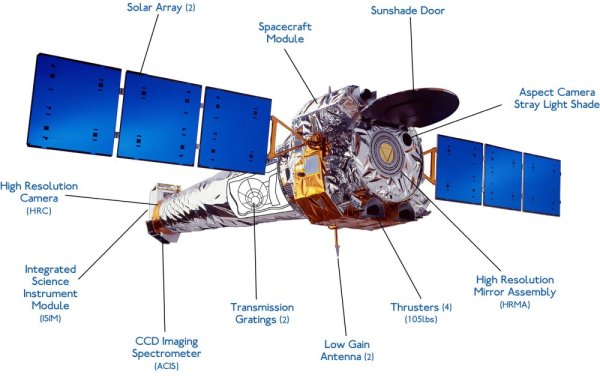
The CHANDRA X-ray Observatory was launched on the 23rd July 1999 by the Space Shuttle Columbia. It was designed to provide high resolution imaging of X-ray sources; as opposed to XMM-NEWTON which has better spectral resolution but worse imaging capabilities. It was the follow up to the EINSTEIN observatory which flew from November 1978 to April 1981and was far superior in all ways. CHANDRA was placed into an elliptical orbit so that it spent little time in the Earths radiation belts, and so allows up to 48hrs (172.8 ksec) of uninterrupted observing time.
 |
| The CHANDRA X-ray Observatory and its instruments. (Image courtesy CHANDRA) |
CHANDRA's mirrors have a focal length of 10 m and the spacecraft carries 4 science instruments - two imaging detectors (High Resolution Camera, HRC and the Advanced CCD Imaging Spectrometer, ACIS) and two spectrometers. The HRC has the highest spatial resolution but very little spectral resolution. It is used for sky surveys and is also the detector for one of the spectrometers, whereas the ACIS detector has good spatial and spectral resolution and much of the science reported in these webpages has come from ACIS. The two spectrometers are the High Energy Transmission Grating and the Low Energy Transmission Grating.
The detectors are kept at very low temperatures (-120 C) so that they are sufficiently sensitive and can record the energy of the incoming photon, when it hit the detector and where it came from on the sky (to 0.5 arc seconds or 1/7200 degrees). The high resolution means that CHANDRA can detect objects 10 times fainter than XMM-NEWTON.
For more information see the CHANDRA website, http://chandra.harvard.edu/
BACK: XMM-NEWTON UP: X-ray Satellites NEXT: New Missions